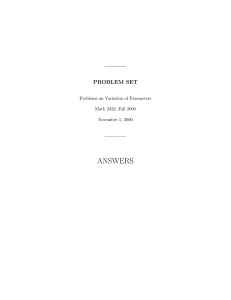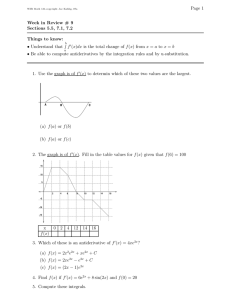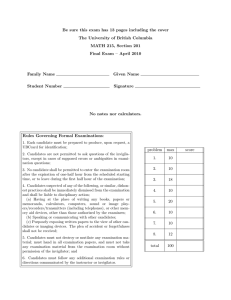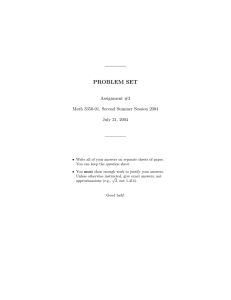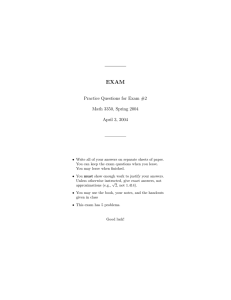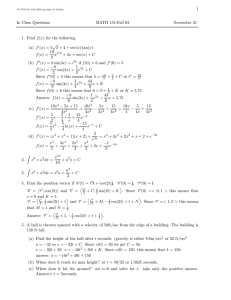Be sure this exam has 13 pages including the cover
advertisement
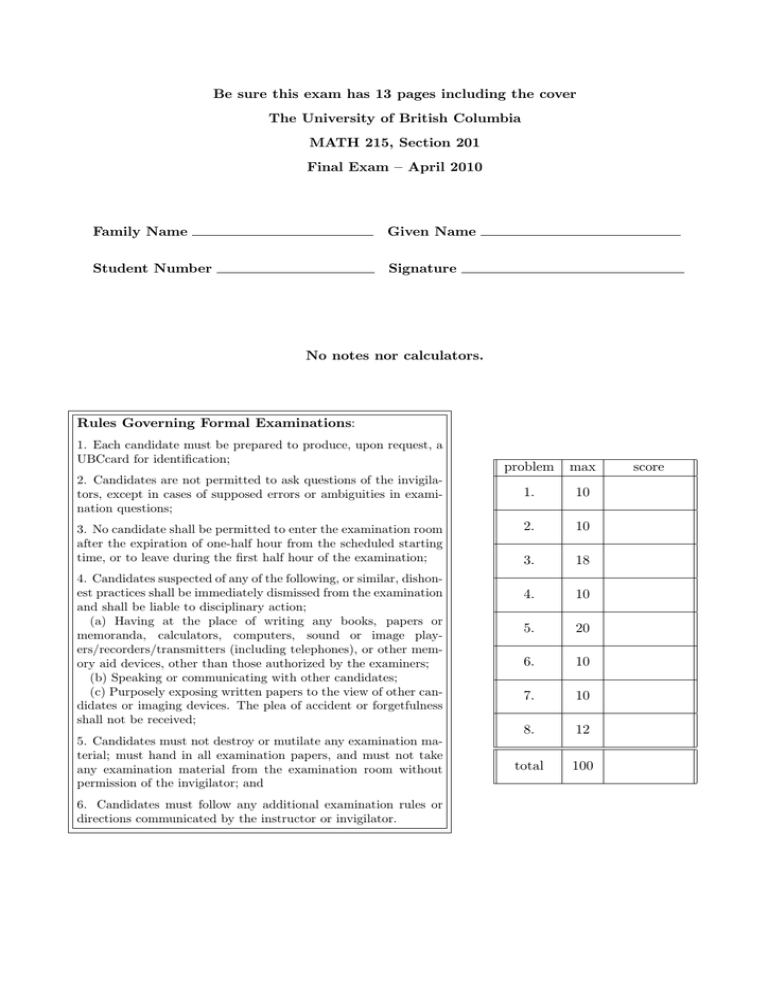
Be sure this exam has 13 pages including the cover
The University of British Columbia
MATH 215, Section 201
Final Exam – April 2010
Family Name
Given Name
Student Number
Signature
No notes nor calculators.
Rules Governing Formal Examinations:
1. Each candidate must be prepared to produce, upon request, a
UBCcard for identification;
2. Candidates are not permitted to ask questions of the invigilators, except in cases of supposed errors or ambiguities in examination questions;
3. No candidate shall be permitted to enter the examination room
after the expiration of one-half hour from the scheduled starting
time, or to leave during the first half hour of the examination;
4. Candidates suspected of any of the following, or similar, dishonest practices shall be immediately dismissed from the examination
and shall be liable to disciplinary action;
(a) Having at the place of writing any books, papers or
memoranda, calculators, computers, sound or image players/recorders/transmitters (including telephones), or other memory aid devices, other than those authorized by the examiners;
(b) Speaking or communicating with other candidates;
(c) Purposely exposing written papers to the view of other candidates or imaging devices. The plea of accident or forgetfulness
shall not be received;
5. Candidates must not destroy or mutilate any examination material; must hand in all examination papers, and must not take
any examination material from the examination room without
permission of the invigilator; and
6. Candidates must follow any additional examination rules or
directions communicated by the instructor or invigilator.
problem
max
1.
10
2.
10
3.
18
4.
10
5.
20
6.
10
7.
10
8.
12
total
100
score
April 2010
Math 215 Section 201 Final Exam
(7 points) 1. (a) Find the solution of the given initial value problem in explicit form:
d
y2
y= ,
dt
t
Answer.
y(1) = 2.
This is §2.2 #12. Write the equation as
y −2 dy = t−1 dt.
Integrating,
−y −1 = ln t + c.
Initial condition gives
c = −1/2.
Thus
y(t) =
(3 points)
2
.
1 − 2 ln t
(b) Determine the interval of existence of the solution in (a).
Answer.
The interval must contain t = 1.
√
The solution makes sense only if t > 0 and ln t 6= 1/2, i.e., t 6= e.
Thus the interval is
√
0<t< e
Page 2 of 13
April 2010
Math 215 Section 201 Final Exam
Page 3 of 13
(10 points) 2. Solve the initial value problem
dy
2x + y 2 + 1
=−
,
dx
y
Answer.
y(0) = 1.
We have
M dx + N dy = 0,
M = 2x + y 2 + 1,
N = y.
Since My = 2y and Nx = 0, it is not exact. Try a multiplier µ(x),
(M µ)y = 2yµ,
(N µ)x = yµx .
Thus µ0 = 2µ. We may take
µ(x) = e2x .
We get
ψx = (2x + y 2 + 1)e2x ,
Thus
Z
ψ=
ψy = ye2x .
1
(2x + y 2 + 1)e2x dx = e2x (x + y 2 ) + h(y).
2
ψy = e2x y + h0 (y) = ye2x ,
or h0 (y) = 0. Hence h(y) =const and the general solution of the DE is given implicitly by the
equation
1
e2x (x + y 2 ) = c, c is a constant.
2
Using the initial condition y(0) = 1, we get c = 1/2. Hence the solution of the IVP is given
implicitly by the equation
e2x (2x + y 2 ) = 1.
Alternative: One has yy 0 + y 2 = −2x − 1. Let u = y 2 . It becomes u0 + 2u = −4x − 2 and
(e2x u)0 = −(4x + 2)e2x . Integrating, e2x y 2 = −2xe2x + c. Initial condition gives c = 1.
√
Remark. Explicit formula: y = e−2x − 2x.
April 2010
Math 215 Section 201 Final Exam
(6 points) 3. (a) Solve y 00 − 5y 0 − 6y = 0,
Page 4 of 13
y(0) = 2, y 0 (0) = −9.
Answer.
The characteristic equation is r2 − 5r − 6 = 0 with roots r = −1, 6. The
general solution is
y(t) = c1 e−t + c2 e6t .
The initial conditions give
c1 + c2 = 2,
Thus c1 = 3, c2 = −1, and
(6 points)
−c1 + 6c2 = −9.
y(t) = 3e−t − e6t .
(b) Use the method of reduction of order to find a second solution y2 (t) of the equation
t2 y 00 + ty 0 − 4y = 0,
t > 0;
y1 (t) = t2
which is independent of y1 .
Answer.
Let y2 = t2 v. Then y20 = t2 v 0 + 2tv and y200 = t2 v 00 + 4tv 0 + 2v. Thus
0 = t2 y200 + ty20 − 4y2 = (t4 v 00 + 4t3 v 0 + 2t2 v) + t3 v 0 + 2t2 v − 4t2 v = t4 v 00 + 5t3 v 0 .
Let w = v 0 . We have
5
w0 + w = 0.
t
dt
−5 and
ThusR dw
w = −5 t and ln w = −5 ln t + c. We conclude w = At
−4
v = w = −At /4 + B. We may take A = −4 and B = 0 to get v = t−4 and
y2 (t) = y1 (t)v(t) = t2 · t−4 = t−2 .
Remark. Some tried explicit solutions of the form y(t) = tn . It is the standard way for
Euler equations but is not the method required by the problem.
April 2010
(6 points)
Math 215 Section 201 Final Exam
(c) Find the general solution of
y 00 + 4y 0 + 4y = t−2 e−2t ,
given that y1 (t) = e−2t and y2 (t) = te−2t solve y 00 + 4y 0 + 4y = 0.
Answer. This is §3.6 #7. The solution is only for t > 0.
Wronskian
W = W [y1 , y2 ] = e−4t .
A particular solution is yp (t) = u1 (t)y1 (t) + u2 (t)y2 (t) with
Z
Z
1
y2 g
te−2t t−2 e−2t
dt = −
u1 (t) = −
dt = −
dt = − ln t
−4t
W
e
t
Z
Z
Z −2t −2 −2t
y1 g
e t e
u2 (t) =
dt =
dt = t−2 dt = −1/t
W
e−4t
Z
Hence
yp (t) = −e−2t ln t − e−2t .
The general solution is
y(t) = c1 e−2t + c2 te−2t − e−2t ln t.
Alternative solution using reduction of order:
Let y = e−2t v. Then y 0 = e−2t (−2v + v 0 ), y 00 = e−2t (4v − 4v 0 + v 00 ) and
e2t (y 00 + 4y 0 + 4y) = v 00 = t−2 .
Integrating,
v 0 = −t−1 + c2 ,
and y = e−2t (− ln t + c2 t + c1 ).
v = − ln t + c2 t + c1 ,
Page 5 of 13
April 2010
Math 215 Section 201 Final Exam
Page 6 of 13
(10 points) 4. Suppose the motion of a certain mass-spring system satisfies the differential equation
u00 + γu0 + 4u = 0,
u(0) = 1,
u0 (0) = a,
(1)
with units m, kg, and s. Here u(t) is the displacement from the equilibrium position, γ > 0 is
the damping coefficient, and a is a real parameter.
(a) Determine the range of γ so that the solution u(t) is not oscillatory.
Answer.
The characteristic equation is r2 + γr + 4 = 0, with roots
p
1
(−γ ± γ 2 − 16).
2
The solution is not oscillatory if γ 2 − 16 ≥ 0, i.e.,
4 ≤ γ < ∞.
(b) Suppose γ = 5. Determine the range of real a so that the solution of (1) returns to the
equilibrium point u = 0 at some t > 0.
Answer.
Here t means finite time.
The characteristic equation is r2 + 5r + 4 = 0, with roots
r = −1, −4.
The general solution to the homogeneous equation is
u(t) = c1 e−t + c2 e−4t .
We have u0 (t) = −c1 e−t − 4c2 e−4t . Invoking the initial conditions,
1 = c1 + c2 ,
Thus c1 =
4+a
3
a = −c1 − 4c2 .
and c2 = − 1+a
3 . Thus
u(t) =
4 + a −t 1 + a −4t
e −
e .
3
3
To return to zero, we need u(t) = 0 for some finite t > 0, i.e.,
e3t =
1+a
.
4+a
1+a
> 1. If a < −4, we need 1 + a < 4 + a which is always true. If a > −4, we
4+a
need 1 + a > 4 + a which is never true. Thus
We need
a < −4.
April 2010
Math 215 Section 201 Final Exam
(6 points) 5. (a) Find the Laplace transform Y (s) of the solution of
(
1
y 00 + y = g(t), g(t) =
cos(t − 2)
y(0) = 1,
if 0 ≤ t < 2
if t ≥ 2
y 0 (0) = 2.
Do NOT attempt to find y(t) !
Answer.
Since
L(y 00 + y) = s2 Y (s) − s − 2 + Y (s).
g(t) = 1 − u2 (t) + u2 (t) cos(t − 2) = 1 + u2 (t)f (t − 2)
with f (t) = cos t − 1, its Laplace transform is
(Lg)(s) =
Thus
Y (s) =
(5 points)
1
s
1
+ e−2s ( 2
− )
s
s +1 s
1
s+2
1
s
− e−2s 2
+
+ e−2s 2
.
s2 + 1 s(s2 + 1)
(s + 1)2
s(s + 1)
(b) Find the inverse Laplace transform of
Answer.
F (s) =
s
.
(s + 1)(s + 2)2
By partial fraction,
F (s) =
a
b
c
+
+
,
s + 1 s + 2 (s + 2)2
and one solves
a = −1,
b = 1,
c = 2.
Thus
(L−1 F )(t) = −e−t + e−2t + 2te−2t .
Page 7 of 13
April 2010
(9 points)
Math 215 Section 201 Final Exam
Page 8 of 13
(c) Find the solution to the initial value problem
y 00 + 2y 0 + 2y = δ(t − π);
y(0) = 1,
y 0 (0) = −2.
Here δ(t) represents the Dirac delta function.
Answer.
Let Ly = Y (s). Then Ly 0 = sY − 1 and Ly 00 = s2 Y − s + 2. Thus
L(y 00 + 2y 0 + 2y) = (s2 + 2s + 2)Y (s) − s.
On the other hand,
L(δ(t − π)) = e−πs .
Thus
Y (s) =
s2
s2
s
1
+ 2
e−πs .
+ 2s + 2 s + 2s + 2
s
s
s+1
1
=
=
−
2
2
+ 2s + 2
(s + 1) + 1
(s + 1) + 1 (s + 1)2 + 1
L−1
s+1
= e−t cos t,
(s + 1)2 + 1
L−1
1
= e−t sin t
(s + 1)2 + 1
Thus
y(t) = e−t cos t − e−t sin t + uπ (t)e−(t−π) sin(t − π)
= e−t cos t − e−t sin t − uπ (t)e−(t−π) sin t
April 2010
Math 215 Section 201 Final Exam
(10 points) 6. For the linear system
·
d
x = Ax,
dt
A=
3 −4
1 −1
Page 9 of 13
¸
,
find the general solution and the matrix etA .
Answer.
Setting det(A − rI) = r2 − 2r + 1 = 0, the eigenvalues are 1, 1. For r = 1, the
eigenvector equation (A − rI)ξ = 0 reduces to ξ1 − 2ξ2 = 0. We can take ξ = (2, 1)T and the
first solution is
µ ¶
2 t
(1)
t
x (t) = ξe =
e.
1
The generalized eigenvector satisfies (A − I)η = ξ, which reduces to η1 − 2η2 = 1. If η2 = k
where k is an arbitrary constant, then η2 = 1 + 2k and η = (1, 0)T + kξ. Taking k = 0, a
second solution is
µ
¶
2t + 1 t
(2)
t
x (t) = (tξ + η)e =
e.
t
The general solution is
x(t) = c1 x
(1)
(t) + c2 x
A fundamental matrix is
µ
¶
2 1
Since Ψ(0) =
with Ψ(0)−1
1 0
e
tA
(2)
µ ¶
µ
¶
2 t
2t + 1 t
(t) = c1
e + c2
e.
1
t
µ
¶
2 2t + 1 t
Ψ(t) =
e.
1
t
µ
¶
0 1
=
, we have
1 −2
−1
= Ψ(t)Ψ(0)
µ
¶
2t + 1
−4t
=
et .
t
−2t + 1
µ ¶
1
Alternative way to find Φ(t): Solve for c1 , c2 so that x(0) =
. This x(t) is the first
0
µ ¶
0
column of Φ(t). Solve for c1 , c2 so that x(0) =
. This x(t) is the second column of Φ(t).
1
April 2010
Math 215 Section 201 Final Exam
(10 points) 7. Solve
¸
1 1
, x(0) =
, A=
,
4 −2
· ¸
·
¸
1
1
d
given that the general solution of dt
x = Ax is xc (t) = c1
e2t + c2
e−3t .
1
−4
d
x = Ax −
dt
·
et
et
¸
·
4
−1
¸
Page 10 of 13
·
Answer.
By the· method
¸ of undetermined coefficients, we first look for a particular solution
a1
of the form xp =
et . Substitution into the ODE yields (after canceling the exponential),
a2
¸ ·
¸
¸ ·
¸·
·
−1
1 1
a1
a1
+
.
=
−1
4 −2
a2
a2
Thus
·
a1
a2
So the general solution is
¸
·
=
·
1
1
x(t) = c1
The initial condition gives
·
4
−1
Thus c1 = 2, c2 = 1, and
·
¸
2t
e + c2
¸
·
= c1
·
x(t) =
2
2
¸−1 ·
0 1
4 −3
1
1
¸
¸
·
+ c2
·
e2t +
1
−4
1
−4
1
1
¸
·
1
1
=
¸
·
e
−3t
1
−4
+
¸
·
+
¸
·
e−3t +
1
1
¸
.
1
1
1
1
¸
et .
¸
¸
et .
µ
¶
µ
¶
1 1
4 1
Answer 2 by diagonalization. AT = T D where T =
, T −1 = 15
,
1 −4
1 −1
µ
¶
µ t¶
2 0
−e
D=T =
. Let y = T −1 x. We have y 0 = Dy + T −1 g = Dy +
, i.e.,
0 −3
0
y10 = 2y1 − et ,
y20 = 3y2
Thus y1 = et + c1 e2t and y2 = c2 e−3t . And x = T y is the solution above.
Answer 3 by variation of parameters
(Duhamel’s formula). From the general
µ 2t
¶
−3t
e
e
solution, Ψ(t) = (x(1) |x(2) ) = 2t
. Thus
e
−4e−3t
µ
¶ µ −t ¶ µ −t ¶
1
−4e2t −e−3t
−e
−e
−1
=
.
Ψ g=
2t
−3t
−t
−t
−e
e
−e
0
−5e
µ −t
¶
Z
e + c1
−1
u= Ψ g=
,
c2
µ −t ¶
µ ¶
e
c
and x(t) = Ψ(t)u(t) = −t + Ψ(t) 1 is the solution above.
e
c2
April 2010
Math 215 Section 201 Final Exam
Page 11 of 13
8. Consider the nonlinear system
dx
= 1 − y,
dt
(4 points)
dy
= x2 − y 2 .
dt
(2)
(a) Find the critical points for the system (2).
Answer.
The critical points are solutions of the equations 1 − y = 0 and
(x − y)(x + y) = 0. The first equation requires that y = 1. Based on the second equation,
x = ±1. Hence the critical points are (−1, 1) and (1, 1).
(2 points)
(b) Find the Jacobian (partial derivative) matrix for the system (2).
Answer.
Defining F (x, y) = 1 − y and G(x, y) = x2 − y 2 , we have
·
¸ ·
¸
Fx (x, y) Fy (x, y)
0 −1
J(x, y) =
=
.
Gx (x, y) Gy (x, y)
2x −2y
April 2010
(6 points)
Math 215 Section 201 Final Exam
Page 12 of 13
(c) Use the linear systems near each critical point to classify them, specifying both the type
of critical point and whether it is (asymptotically) stable or unstable.
Answer.
is
At the critical point (−1, 1), the coefficients matrix of the linearized system
·
¸
0 −1
−2 −2
√
√
with characteristic equation r2 + 2r − 2 = 0 and eigenvalues −1 − 3 and −1 + 3. The
eigenvalues are real, with opposite sign. Hence the critical point is a saddle, which is
unstable.
At the equilibrium point (1, 1), the coefficients of the linearized system is
·
¸
0 −1
2 −2
with characteristic equation r2 + 2r + 2 = 0 and complex conjugate eigenvalues −1 ± i.
The critical point is a stable spiral, which is asymptotically stable.
April 2010
Math 215 Section 201 Final Exam
Table of Laplace transforms
f (t) = L−1 {F (s)}
1. 1
2. eat
3. tn , n positive integer
4. tp , p > −1
5. sin(at)
6. cos(at)
7. sinh(at)
8. cosh(at)
9. eat sin(bt)
F (s) = L{f (t)}
1
, s>0
s
1
, s>a
s−a
n!
, s>0
n+1
s
Γ(p + 1)
, s>0
sp+1
a
, s>0
2
s + a2
s
, s>0
s2 + a2
a
, s > |a|
2
s − a2
s
, s > |a|
2
s − a2
b
, s>a
(s − a)2 + b2
10. eat cos(bt)
s−a
, s>a
(s − a)2 + b2
11. tn eat , n positive integer
n!
,
(s − a)n+1
12. uc (t)
e−cs
, s>0
s
13. uc (t)f (t − c)
e−cs F (s)
14. ect f (t)
F (s − c)
15. f (ct)
Z t
16.
f (t − τ )g(τ )dτ
1 ³s´
F
,
c
c
s>a
c>0
F (s)G(s)
0
17. δ(t − c)
e−cs
18. f (n) (t)
sn F (s) − sn−1 f (0) − ... − f (n−1) (0)
19. (−t)n f (t)
F (n) (s) = (
d n
) F (s)
ds
Page 13 of 13
